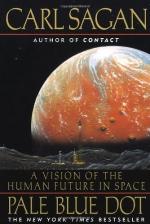
|
| Name: _________________________ | Period: ___________________ |
This test consists of 15 multiple choice questions and 5 short answer questions.
Multiple Choice Questions
1. Sagan suggests that throughout history, many have claimed that our species is what?
(a) Irredeemable.
(b) Unique.
(c) Essentially good.
(d) Worthless.
2. How does Sagan characterize NASA?
(a) As a faceless and dispassionate monolith.
(b) As an aging bureaucracy.
(c) As part of the military-industrial complex.
(d) As a ship without a tiller or rudder.
3. Besides the Voyager spacecraft, what does Sagan cite as a major triumph by NASA?
(a) The Mars rovers.
(b) The Gemini project.
(c) The Hubble Telescope.
(d) The moon landings.
4. What does Neptune's moon have less of compared to Titan?
(a) Iron.
(b) Carbon.
(c) Ice.
(d) Potassium.
5. What major component of the Voyager craft was threatened in Sagan's plan to take a distant picture of Earth?
(a) The spectral analyzer.
(b) The vidicon system.
(c) The telemetry antenna.
(d) The solar panel array.
6. What is the most important thing that would immediately be apparent to any alien intelligence that found the Voyager probes?
(a) That the probes were intelligently designed.
(b) The location of Earth.
(c) How to decode the records.
(d) The human DNA sequence.
7. What scientist is credited with making the first discoveries that caused problems for the geocentric theory?
(a) Kelper.
(b) Galileo.
(c) Ptolemy.
(d) Copernicus.
8. What unusual source of energy do the Voyager spacecraft take advantage of?
(a) Cosmic rays.
(b) Planetary gravity.
(c) Solar wind.
(d) Vacuum energy.
9. What visual resolution would be required to determine the existence of intelligent life on Earth?
(a) 1 meter.
(b) 1,000 meters.
(c) 100 meters.
(d) 10 cm.
10. What planet represents the farthest distance from Earth that the Voyager craft were intended to function at?
(a) Jupiter.
(b) Saturn
(c) Uranus.
(d) Mars.
11. What was the state of the knowledge and belief about life on other planets at the time the book was written?
(a) Scientists expected to find life on most of the planets and moons.
(b) It was believed there was abundant life on Mars.
(c) Most believed life on other planets was impossible.
(d) No signs of life were known to exist.
12. Which of the following does Sagan NOT cite as evidence for the age of the universe?
(a) Telemetric spectrometry.
(b) Star evolution.
(c) Impact craters.
(d) Radioactive dating.
13. Sagan suggests that the image of the "pale blue dot" teaches the need for what?
(a) Space exploration.
(b) Kindness.
(c) Science education.
(d) Peace.
14. The Voyager probes found large amounts of what element on Titan?
(a) Helium.
(b) Iridium.
(c) Oxygen.
(d) Nitrogen.
15. Sagan expects both Voyager spacecrafts to continue to broadcast data through what year?
(a) 2015.
(b) 2010.
(c) 2050.
(d) 2030.
Short Answer Questions
1. What is the major difference between space exploration and human exploration in the past?
2. When was Neptune discovered?
3. What role does Sagan suggest that religion has played in the development of science?
4. What are the records on the Voyager craft engraved in?
5. About how long does Sagan suggest that human beings have been "settled down"?
|
This section contains 489 words (approx. 2 pages at 300 words per page) |

|




